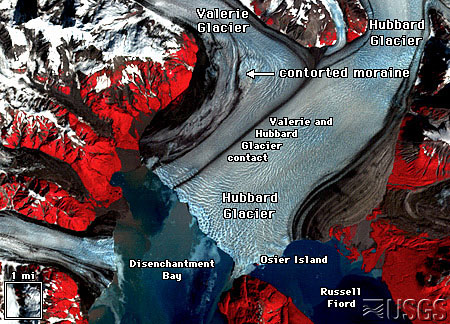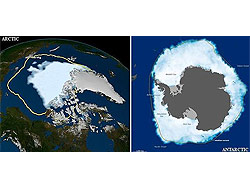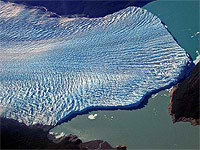    |

 |
|  | |||||||||||||||||||||||||||||||||||||||||||||||
Posts | Terrestres | GlaciologíaEl glaciar que no está retrocediendo: Hubbard GlacierMuchos glaciares se están derritiendo a velocidades diversas, pero hay algunos glaciares que no solo no se derriten sino que de hecho están avanzando, este es uno de esos casos. Publicado: Sábado, 21/3/2009 - 23:50 | 10206 visitas.
El Hubbard Glacier es una gigantesca masa de hielo ubicada en Alaska, Estados Unidos y Yukón, Canadá; se extiende 122 kilómetros en las bahías de Yakutat y Disenchantment. Este glaciar se ha unido al Glaciar Valerie al oeste y juntos han avanzado hasta amenazar con bloquear el fiordo Russell. Sin embargo ello ya sucedió en 1986 cuando el glaciar cerró en pleno verano el paso al fiordo y creó el "lago Russell", la presa natural creada llegó a tener una cota de 25 metros por encima del agua y con la salinidad en descenso amenazando la vida marina. En la primavera de 2002 una morrena terminal volvió a cerrar el paso del fiordo, se cree que en algún momento el avance del glaciar lo cierre permanentemente. Este hecho natural ocurrido en el glaciar Hubbard contradice la teoría del calentamiento global y reduce la base de la aún menos sostenible hipótesis sobre la contribución humana al supuesto cambio climático. Lo más probable es que el ser humano tiene un impacto importante pero sólo localmente en la temperatura de áreas intensamente pobladas, y que el clima global en realidad se compone de sistemas climáticos regionales con complejas interacciones, que a nivel global no tienen significado, pero cada sistema individualmente tiene una historia y tendencia de temperatura determinadas y factores que inciden en estas tendencias en una forma distinta, siendo el más importante de estos factores, la radiación solar. Parte de una buena investigación científica implica considerar los puntos débiles de una teoría y considerar los datos que contradicen la tesis que está siendo probada, que pueden poner en duda las premisas asumidas por el científico. De esto se trata la ciencia: de evidencias que nos permitan concebir una mejor conjetura y aceptar la posibilidad de que nuevos hechos aparezcan y refuten lo que conocíamos. Así, aunque Al Gore y otros políticos demagogos insistan en vendernos sus soluciones para males, cuya existencia y causas están en duda, lo mejor que tenemos a mano es el método científico como único camino para obtener conocimiento real. Referencias: Hubbard Glacier, Alaska: Growing and Advancing in Spite of Global Climate Change and the 1986 and 2002 Russell Lake Outburst Floods., D.C. Trabant, R.S. March, and D.S. Thomas, USGS, U.S. Department of the Interior U.S. Geological Survey: http://pubs.usgs.gov/fs/fs-001-03/fs-001.03.pdf
| EntradasNoticiasImágenes
Videos
Artículos | ||||||||||||||||||||||||||||||||||||||||||||||||




 Imagen: Hilary Slater
Imagen: Hilary Slater





